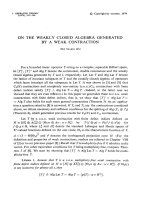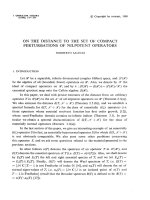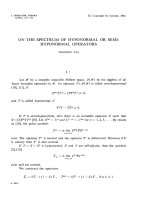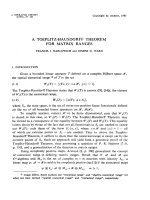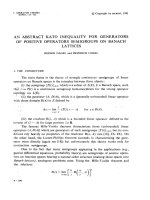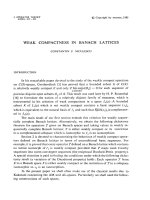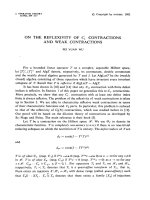Báo cáo toán học: "On the Generalized Convolution with a Weight - Function for Fourier, Fourier Cosine and Sine Transforms" pot
Bạn đang xem bản rút gọn của tài liệu. Xem và tải ngay bản đầy đủ của tài liệu tại đây (140.62 KB, 16 trang )
Vietnam Journal of Mathematics 33:4 ( 2005) 421–436
On the Generalized Convolution
with a Weight - Function for Fourier,
Fourier Cosine and Sine Transforms
Nguy en Xuan Thao
1
and Nguyen Minh Khoa
2
1
Hanoi Water Resources University,
175 Tay Son, Dong Da, Hanoi, Vietnam
2
Hanoi Universtity of Transport and Communications,
Lang Thuong, Dong Da, Hanoi, Vietnam
Received December 15, 2004
Revised July 2005
Abstract. A generalized convolution for Fourier, Fourier cosine and sine transforms
is introduced. Its properties and applications t o solving systems of integral equations
are presented.
1. Introduction
The convolution for integral transforms were studied in the 19
th
century, at first
the convolutions for the Fourier transform (see, e.g. [3, 20]), for the Laplace
transform (see [18, 20] and the references therein) for the Mellin transform
[18] and after that the convolutions for the Hilbert transform [4, 21], the Han-
kel transform [7, 22], the Kontorovich–Lebedev transform [7, 26], the Stieltjes
transform [19, 23], the convolutions with a weigh-function for the Fourier cosine
transform [14].
The convolutions for different integral transforms have numerous applications
in several contexts of science and mathematics [5, 6, 11, 18, 21, 25].
The convolution of two functions f and g for the Fourier integral transform
F is defined by [3, 20]
(f ∗ g)(x)=
1
√
2π
+∞
−∞
f(x −y)g(y)dy, x ∈ R, (1)
422 Nguyen Xuan Thao and Nguyen Minh Khoa
for which the factorization property holds
F (f ∗ g)(y)=(Ff)(y)(Fg)(y), ∀y ∈ R. (2)
Here the integral Fourier transform takes the form
(Ff)(y)=
1
√
2π
+∞
−∞
f(x)e
−iyx
dx.
The convolution of two functions f and g for the Fourier cosine transform F
c
is
also given [3, 20]
(f ∗
F
c
g)(x)=
1
√
2π
+∞
0
f(y)
g(|x −y|)+g(x + y)
dy, x > 0, (3)
with the factorization property
F
c
(f ∗
F
c
g)(y)=(F
c
f)(y).(F
c
g)(y), ∀y>0, (4)
where the integral Fourier cosine transform is [3, 20]
(F
c
f)(y)=
2
π
+∞
−∞
f(x)cos(yx)dx.
The convolutions of two functions f and g for the Laplace integral transform L
has the form [18, 23]
(f ∗ g)(x)=
x
0
f(x −t)g(t)dt, x > 0, (5)
which satisfies the factorization equality
L(f ∗g)(y)=(Lf)(y)(Lg)(y),y= c + it, t ∈ R, (6)
where the Laplace integral transform is defined by [18, 23]
(Lf)(y)=
+∞
0
e
−yx
f(x)dx.
The generalized convolution for the Fourier sine and cosine transforms was
first introduced by Churchill in 1941 [3]
(f ∗
1
g)(x)=
1
√
2π
+∞
0
f(y)
g(|x −y|) −g(x + y)
dy, x > 0(7)
for which the factorization property holds
F
s
(f ∗
1
g)(y)=(F
s
f)(y)(F
c
g)(y), ∀y>0. (8)
In the 90s of the last century, Yakubovic published some papers on special cases
of genneralized convolutions for integral transforms according to index [17, 24,
On the Generalized Convolution with a Weight - Function 423
26]. In 1998, Kakichev and Thao proposed a constructive method of defining the
generalized convolution for any integral transforms K
1
,K
2
,K
3
with the weight-
function γ(y) [8] of functions f, g for which we have the factorization property
K
1
(f
γ
∗ g)(y)=γ(y)(K
2
f)(y)(K
3
g)(y).
In recent years, there have been published some works on generalized convolu-
tion, for instance: the generalized convolution for integral transforms Stieltjes,
Hilbert and the cosine-sine transforms [12], the generalized convolution for H-
transform [9], the generalized convolution for I-transform [16]. For example, the
generalized convolution for the Fourier cosine and sine has been defined [13] by
the identity:
(f ∗
2
g)(x)=
1
√
2π
+∞
0
f(y)
sign(y −x)g(|y − x|)+g(y + x)
dy, x > 0(9)
for which the factorization property holds
F
c
(f ∗
2
g)(y)=(F
s
f)(y)(F
s
g)(y), ∀y>0. (10)
In this article we will give a notion of the generalized convolution with a
weight-function of functions f and g for the Fourier, Fourier sine and cosine
integral transforms. We will prove some of its properties as well as point out
some of its relationships to several well-known convolutions and generalized con-
volutions. Also we will show that there does not exist the unit element for the
calculus of this generalized convolution as well as there is not aliquote of zero.
Finally, we will apply this notion to solving systems of integral equations.
2. Generalized Convolution for the Fouri er, Fourier Cosine and Sine
Tran s form s
Definition 1. Genneralized convolution with the weight-function γ(y)=sign y
for the Fourier, Fourier cosine and sine transforms of functions f and g is
defined by
(f
γ
∗ g)(x)=
i
√
2π
+∞
0
f(|x −u|) − f(|x + u|)
g(u)du, x ∈ R (11)
Denote by L(R
+
) the set of all functions f defined on (0, ∞) such that
+∞
0
f(x)
dx < +∞.
Theorem 1. Let f and g be functions in L(R
+
). Then the genneralize d con-
volution with the weight-function γ(y)=sign y for the Fourier, Fourier cosine
and sine transforms of functions f and g has a meaning and belongs to L(R)
and the factorization property holds
424 Nguyen Xuan Thao and Nguyen Minh Khoa
F (f
γ
∗ g)(y)=signy(F
c
f)(|y|)(F
s
g)(|y|), ∀y ∈ R. (12)
Proof. Based on (11) and the hypothesis that f and g ∈ L(R
+
)wehave
+∞
−∞
(f
γ
∗ g)(x)
dx =
1
√
2π
+∞
−∞
+∞
0
|g(u)|
f(|x −u|) − f(|x + u|)
dudx
1
√
2π
+∞
0
|g(u)|
+∞
−∞
f(|x −u|)
dx +
+∞
−∞
f(|x + u|)
dx
du
=2
2
π
+∞
0
|g(u)|du
+∞
0
|f(v)|dv < +∞.
Therefore, (f
γ
∗ g)(x) ∈ L(R).
Further,
sign y(F
c
f)(|y|)(F
s
g)(|y|)=(F
c
f)(y)(F
s
g)(y)
=
2
π
+∞
0
+∞
0
cos(yu)sin(yv)f(u)g(v)dudv
=
1
π
+∞
0
+∞
0
sin y(u + v) − sin y(u −v)
f(u)g(v)dudv
=
1
π
+∞
0
+∞
v
sin(yt)f (t − v)g(v)dtdv −
+∞
0
+∞
−v
sin(yt)f (|t + v|)g(v)dtdv
=
1
π
+∞
0
+∞
0
sin(yt)
f(|t −v|) − f(|t + v|)
g(v)dtdv
−
1
π
+∞
0
v
0
sin(yt)
f(|t −v|) − f(|t + v|)
g(v)dtdv
−
1
π
+∞
0
0
−v
sin(yt)
f(|t −v|) −f (|t + v|)
g(v)dtdv.
On the other hand,
0
−v
sin(yt)
f(|t −v|) − f(|t + v|)
dt = −
v
0
sin(yt)
f(|t −v|) − f(|t + v|)
dt.
Therefore,
On the Generalized Convolution with a Weight - Function 425
sign y(F
c
f)(|y|)(F
s
g)(|y|)
=
1
√
2π
2
π
+∞
0
sin yt
+∞
0
f(|t −v|) −f (|t + v|)
g(v)dv
dt.
(13)
Since, if h(x) is odd,
(Fh)(x)=−i(F
s
h)(x),x∈ R (14)
from (13) and (14) we obtain
sign y(F
c
f)(|y|)(F
s
g)(|y|)
=
1
√
2π
i
√
2π
+∞
−∞
e
iyt
+∞
0
f(|t −v|) − f(|t + v|)
g(v)dv
dt
= F(f
γ
∗ g)(y).
The proof is complete.
Corollary 1. The generalize d convolution (11) can be represented by
(f
γ
∗g)(x)=
i
√
2π
+∞
0
f(u)
sign(x + u)g(|x + u|)+sign(x −u)g(|x −u|)
du. (15)
Proof. Indeed for x ≥ 0, with the substitution x + u = v,weget
+∞
0
f(u)sign(x + u)g(|x + u|)du =
+∞
x
f(v − x)signvg(|v|)dv
=
+∞
0
f(|v − x|)g(v)dv −
x
0
f(|v − x|)signvg(|v|)dv.
(16)
Similarly, with the substitution x −u = −v,wehave
+∞
0
f(u)sign(x −u)g(|x −u|)du =
+∞
−x
f(x + v)sign(−v)g(|v|)dv
= −
+∞
0
f(x + v)g(|v|)dv +
0
−x
f(x + v)g(|v|)dv.
(17)
On the other hand,
426 Nguyen Xuan Thao and Nguyen Minh Khoa
x
0
f(|v − x|)signvg(|v|)dv =
0
−x
f(|v + x|)g(|v|)dv.
From this and (16), (17) we have
i
√
2π
+∞
0
f(u)
sign (x+u)g(|x + u|)+ sign (x −u)g(|x −u|)
du
=
i
√
2π
+∞
0
g(v)
f(|v − x|) −f (|v+x|)
dv.
(18)
Similarly, for x<0, we have
i
√
2π
+∞
0
f(u)
sign (x + u)g(|x + u|)+ sign(x − u)g(|x − u|)
du
=
i
√
2π
+∞
0
g(v)
f(|v − x|) −f (|v + x|)
dv.
(19)
The equalities (18) and (19) yield (15). The proof is complete.
Theorem 2. In the space of functions belonging to L(R
+
) the generalized co n-
volution (11) is not commutative
(f
γ
∗ g)(x)=−(g
γ
∗ f)(x)+i
2
π
(f ∗
L
g)(|x|)sign x (20)
where (f ∗
L
g) is defined by (5).
Proof. Indeed,
(i) for x ≥ 0, by Definition 1, we have
(f
γ
∗ g)(x)=
i
√
2π
+∞
0
f(|u −x|) −f(x + u)
g(|u|)du.
With the substitutions u − x = t, x + u = t we get
(f
γ
∗ g)(x)=
i
√
2π
+∞
−x
f(|t|)g(x + t)dt −
+∞
x
f(t)g(|t −x|)dt
=
i
√
2π
+∞
0
f(|t|)g(x + t)dt −
+∞
0
f(t)g(|t −x|)dt
+
0
−x
f(|t|)g(x + t)dt +
x
0
f(t)g(|t −x|)dt
On the Generalized Convolution with a Weight - Function 427
=
i
√
2π
−
+∞
0
g(|x −t|) − g(|x + t|)
f(t)dt +
x
0
f(t)g(|t −x|)dt+
+
x
0
f(u)g(x −u)du
= −(g
γ
∗ f)(x)+i
2
π
(f ∗
L
g)(x). (21)
Similarly
ii) for x<0wehave
(f
γ
∗ g)(x)=
i
√
2π
+∞
0
f(|x −u|) −f(|x + u|)
g(u)du,
with the substitutions v = u − x, t = x + u we get
(f
γ
∗ g)(x)=
i
√
2π
+∞
−x
f(|v|)g(|x + v|)dv −
+∞
x
f(|t|)g(|t −x|)dt
=
i
√
2π
+∞
0
f(|v|)g(|x + v|)dv −
−x
0
f(v)g(|x + v|)dv
−
+∞
0
f(|t|)g(|t −x|)dt −
0
x
f(|t|)g(|t −x|)dt
=
i
√
2π
−
+∞
0
g(|t −x|) − g(|t + x|)
f(t)dt −
−x
0
f(v)g(|x + v|)dv
−
0
−x
f(|−u|)g(|−u −x|)(−du)
= −(g
γ
∗ f)(x) −i
2
π
(f ∗
L
g)(−x). (22)
The equalities (21) and (22) yield (20).
The proof is complete.
Theorem 3. In the space of functions belonging to L(R
+
) the generalized co n-
volution (11) is not associative and satisfies the following equalities
a)
f
γ
∗ (g
γ
∗ h)
(x)=
g
γ
∗ (f
γ
∗ h)
(x)
b)
f
γ
∗ (g
γ
∗ h)
(x)=i
(f ∗
F
c
g)
γ
∗ h
(x), ∀x ∈ R
428 Nguyen Xuan Thao and Nguyen Minh Khoa
where (f ∗
F
c
g) is defined by (2).
Proof. a) From the factorization property
F (f
γ
∗ g)(y)=signy(F
c
f)(|y|)(F
s
g)(|y|), ∀y ∈ R.
On the other hand, because (f
γ
∗ g)(x) is odd,
F
s
(f
γ
∗ g)(|y|)=signyF
s
(f
γ
∗ g)(y)
=signy
− iF(f
γ
∗ g)(y)
= − i(F
c
f)(|y|)(F
s
g)(|y|). (23)
By (23) we have
F
g
γ
∗ (f
γ
∗ h)
(y)=signy(F
c
g)(|y|)F
s
(f
γ
∗ h)(|y|)
=(F
c
g)(|y|) ×
− i sign y(F
c
f)(|y|)(F
s
h)(|y|)
=(F
c
f)(|y|) ×
− i sign y(F
c
g)(|y|)(F
s
h)(|y|)
=(F
c
f)(|y|) ×F
s
(g
γ
∗ h)(|y|)sign y
= F(f
γ
∗ (g
γ
∗ h)
(y), ∀y ∈ R.
From this we get: f
γ
∗(g
γ
∗h)=g
γ
∗(f
γ
∗h). So the generalized convolution (11) is
not associative and satisfies the equality f
γ
∗ (g
γ
∗ h)=g
γ
∗ (f
γ
∗ h). The proof for
b) is similar to that of a).
The theorem is proved.
Theorem 4. In the space of functions belonging to L(R
+
) the operation of
the generalize d convolution (11) does not have the unit element but the left unit
element e
1
=
−i sin 2x
√
2πx
.
Proof. Suppose that there exists the right unit element e
2
of the operation of
the generalized convolution (11) in the space of functions in L(R
+
):
f(x) ≡ (f
γ
∗ e
2
)(x), ∀x>0.
Therefore
F (f
γ
∗ e
2
)(y)=(Ff)(y), ∀y ∈ R, ∀f ∈ L(R
+
).
From the factorization property, we have
sign y(F
c
f)(|y|)(F
s
e
2
)(|y|)=(Ff)(y), ∀y ∈ R, ∀f ∈ L(R
+
).
It follows that
(F
c
f)(y)(F
s
e
2
)(y)=(Ff)(y), ∀y ∈ R, ∀f ∈ L(R
+
).
With an even function f,weget
On the Generalized Convolution with a Weight - Function 429
(F
c
f)(y).(F
s
e
2
)(y)=(F
c
f)(y), ∀y ∈ R.
Hence
(F
s
e
2
)(y)=1, ∀y ∈ R. (24)
When y ≥ 0, we have
(F
s
e
2
)(y)=−(F
s
e
2
)(−y)=−1
This is a contradition with (24).
Thus the generalized convolution (11) does not have the right unit element,
and so does not have the unit element. We prove that the generalized convolution
(11) have the left unit element.
Indeed, we have e
1
=
−i sin 2x
√
2πx
∈ L(R
+
). We prove
(e
1
γ
∗ g)(x)=g(x), ∀x>0.
Putting l
0
=
sin 2x
√
2πx
,weget
F (e
1
γ
∗ g)(y)=signy(F
c
e
1
)(|y|)(F
s
g)(|y|)
=signyF
c
(−il
0
)(|y|)(F
s
g)(|y|)
= −isign y(F
c
l
0
)(|y|)(F
s
g)(|y|)
= −isign y(F
c
l
0
)(y)(F
s
g)(|y|).
On the other hand, since
+∞
0
cos(−yx)sinx cos x
dx
x
=
π
2
(the formula 3.382.35 [1, p. 470]), we have (F
c
l
0
)(y)=1, ∀y>0.
We obtain
F (e
1
γ
∗ g)(y)=−i sign y(F
s
g)(|y|)=−i(F
s
g)(y)=(Fg)(y), ∀y ∈ R.
Therefore (e
1
γ
∗g)(x)=g(x), ∀x>0. Thus, e
1
is the left unit element belonging
to L(R
+
).
The theorem is proved.
Set L(e
x
,R
+
)=
f :
+∞
0
e
x
|f(x)|dx < +∞
.
Theorem 5. (Titchmarch type - Theorem) Let f and g ∈ L(e
x
,R
+
),if(f
γ
∗
g)(x) ≡ 0 ∀x ∈ R, then either f(t)=0or g(t)=0, ∀t>0.
Proof. Under the hypothesis (f
γ
∗g)(x) ≡ 0 ∀x ∈ R it follows that F (f
γ
∗g)(y)=
0, ∀y ∈ R.
430 Nguyen Xuan Thao and Nguyen Minh Khoa
By virture of Theorem 1,
sign y(F
c
f)(|y|)(F
s
g)(|y|)=0, ∀y ∈ R. (25)
As (F
c
f)(|y|)and(F
s
g)(|y|) are analytic ∀y ∈ R from (25) we have (F
c
f)(|y|)=
0, ∀y ∈ R or (F
s
g)(|y|)=0, ∀y ∈ R. It follows that f (x)=0,∀x ∈ R
+
or
g(x)=0, ∀x ∈ R
+
.
The theorem is proved.
Theorem 6. The generalized convolution (11) relates to the known convolutions
as follows:
a) (f
γ
∗ g)(x)=i(g ∗
1
f)(|x|)sign x
b) (f
γ
∗ g)(x)=i
(f
·
◦ h)(y) ∗
F
(g
·
◦ h)(y)signy
(x)
where h(x)=|x| and (f ∗
F
g) is defined by (1).
Proof. From (11), when x ≥ 0wehave:(f
γ
∗ g)(x)=i(g ∗
1
f)(x)
For x ≤ 0
(f
γ
∗ g)(x)=
i
√
2π
+∞
0
g(u)
f
|x| + u
− f
u −|x|
dx
=
−i
√
2π
+∞
0
g(u)
f
|x|−u
− f
|x| + u
du = −i(g ∗
1
f)(|x|).
Thus, we have a).
On the other hand, we have
i
(f ◦ h)(y) ∗
F
(g ◦ h)(y)signy
(x)=
i
√
2π
+∞
−∞
g(|u|).f (|x −u|)signudu
=
i
√
2π
+∞
0
g(u)f (|x −u|)du −
i
√
2π
0
−∞
g(|u|)f (|x −u|)du
=
i
√
2π
+∞
0
g(u)f (|x −u|)du −
i
√
2π
+∞
0
g(|u|)f (|x + u|)du
=
i
√
2π
+∞
0
g(u)
f(|x −u|) −f(|x + u|)
du
=(f
γ
∗ g)(x).
The theorem is proved.
On the Generalized Convolution with a Weight - Function 431
3. Application to Solving Systems of Integral Equations
a) Consider the system of integral equations
f(y)+λ
1
+∞
0
g(t)θ
1
(y, t)dt = k(y),y>0
λ
2
+∞
0
θ
2
(t)
f(|x −t|) − f(|x + t|)
dt + g(|x|)sign x = h(|x|)sign x, x ∈ R.
(26)
Here, λ
1
,λ
2
are complex constants and ϕ, ψ, k are functions of L(R
+
), f and g
are the unknown functions, and
θ
1
(y, t)=
1
√
2π
sign(t −y)ϕ(|t − y|)+ϕ(t + y)
θ
2
(t)=
i
√
2π
ψ(t).
Theorem 7. With the condition
1 −iλ
1
λ
2
(F
s
ϕ)(y)(F
s
ψ)(y) =0, ∀y>0,
there exists a solution in L(R
+
) of (26) which is defined by
f(y)=k(y) − λ
1
(h ∗
2
ϕ)(y) − (k ∗
F
c
l)(y)+λ
1
(h ∗
2
ϕ) ∗
F
c
l
(y)
g(y)=h(y) −λ
2
(k
γ
∗ ϕ)(y) − (h ∗
1
l)(y)+λ
2
(k
γ
∗ ψ) ∗
1
l
(y).
Here, l ∈ L(R
+
) anddefinedby
(F
c
l)(y)=
−iλ
1
λ
2
F
c
(ϕ ∗
2
ψ)(y)
1 −iλ
1
λ
2
F
c
(ϕ ∗
2
ψ)(y)
.
Proof. System (26) can be re-written in the form
f(y)+λ
1
(ϕ ∗
2
g)(y)=k(y),y>0
λ
2
(f
γ
∗ ψ)(x)+g(|x|)sign x = h(|x|)sign x, x ∈ R.
Using the factorization property of the convolution (11) and (f ∗
2
g)(x)wehave
(F
c
f)(y)+λ
1
(F
s
ϕ)(y)(F
s
g)(y)=(F
c
k)(y),y>0
λ
2
(F
c
f)(y)(F
s
ψ)(y) − i(F
s
g)(y)=−i(F
s
h)(y),y>0.
Accordingly, we have
Δ=
1 λ
1
(F
s
ϕ)(y)
λ
2
(F
s
ψ)(y) −i
= −i
1 −iλ
1
λ
2
(F
s
ϕ)(y)(F
s
ψ)(y)
=0
Δ
1
=
(F
c
k)(y) λ
1
(F
s
ϕ)(y)
−i(F
s
h)(y) −i
= −i(F
c
k)(y)+iλ
1
(F
s
h)(y)(F
s
ϕ)(y)
432 Nguyen Xuan Thao and Nguyen Minh Khoa
Therefore,
(F
c
f)(y)=
Δ
1
−i
−
Δ
1
−i
−iλ
1
λ
2
F
c
(ϕ ∗
2
ψ)(y)
1 −iλ
1
λ
2
F
c
(ϕ ∗
2
ψ)(y)
,y>0.
Due to Wiener-Levy’s theorem [2], there exists a continuous function l ∈ L(R
+
)
such that
(F
c
l)(y)=
−iλ
1
λ
2
F
c
(ϕ ∗
2
ψ)(y)
1 −iλ
1
λ
2
F
c
(ϕ ∗
2
ψ)(y).
It follows that
(F
c
f)(y)=
Δ
1
−i
−
Δ
1
−i
(F
c
l)(y)
=(F
c
k)(y) −λ
1
F
c
(h ∗
2
ϕ)(y) −[(F
c
k)(y) −λ
1
F
c
(h ∗
2
ϕ)(y)](F
c
l)(y)
=(F
c
k)(y) −λ
1
F
c
(h ∗
2
ϕ)(y) −F
c
(k ∗
F
c
l)(y)+λ
1
F
c
(h ∗
2
ϕ) ∗
F
c
l
(y),y>0.
Hence
f(y)=k(y) − λ
1
(h ∗
2
ϕ)(y) −(k ∗
F
c
l)(y)+λ
1
(h ∗
2
ϕ) ∗
F
c
l
(y) ∈ L(R
+
).
Similarly,
Δ
2
=
1(F
c
k)(y)
λ
2
(F
s
ψ)(y) −i(F
s
h)(y)
= −i(F
s
h)(y) − λ
2
(F
c
k)(y)(F
s
ψ)(y)
= − i(F
s
h)(y)+iλ
2
F
s
(k
γ
∗ ψ)(y).
It follows that
(F
s
g)(y)=
Δ
2
−i
−
Δ
2
−i
(F
c
l)(y)
=(F
s
h)(y) − λ
2
F
s
(k
γ
∗ ψ)(y) −
(F
s
h)(y) − λ
2
F
s
(k
γ
∗ ψ)(y)
(F
c
l)(y)
=(F
s
h)(y) − λ
2
F
s
(k
γ
∗ ψ)(y) − F
s
(h ∗
1
l)(y)+λ
2
F
s
k
γ
∗ ψ) ∗
1
l
(y).
Hence
g(y)=h(y) − λ
2
(k
γ
∗ ψ)(y) − (h ∗
1
l)(y)+λ
2
k
γ
∗ ψ) ∗
1
l
(y) ∈ L(R
+
).
The theorem is proved.
b) Consider the system of integral equations
f(y)+λ
1
+∞
0
g(t)θ
1
(y, t)dt = k(y),y>0
λ
2
+∞
0
f(t)θ
2
(x, t)dt + g(|x|)sign x = h(|x|)sign x, x ∈ R.
(27)
On the Generalized Convolution with a Weight - Function 433
Here, λ
1
,λ
2
are complex constants and ϕ, ψ, k are functions of L(R
+
), f and g
are the unknown functions, and
θ
1
(y, t)=
1
√
2π
ϕ(|t −y|)+ϕ(t + y)
θ
2
(x, t)=
i
√
2π
ψ(|x −t|) − ψ(|x + t|)
.
Theorem 8. With the condition
1 −iλ
1
λ
2
(F
c
ϕ)(y)(F
c
ψ)(y) =0, ∀y>0
there exists a solution in L(R
+
) of (27) which is defined by
f(y)=k(y) − λ
1
(h ∗
1
ϕ)(y)+(k ∗
1
l)(y) −λ
1
(l
γ
∗ (ϕ
γ
∗ h))(y)
g(y)=h(y) − λ
2
(ψ
γ
∗ k)(y) − (h ∗
1
l)(y)+λ
2
(l
γ
∗ (k ∗
1
ψ))(y).
Here, l ∈ L(R
+
) anddefinedby(F
c
l)(y)=
−iλ
1
λ
2
F
c
(ϕ ∗
F
c
ψ)(y)
1 −iλ
1
λ
2
F
c
(ϕ ∗
F
c
ψ)(y)
.
Proof. Sytems (27) canbe-written in the form
f(y)+λ
1
(g ∗
1
ϕ)(y)=k(y),y>0
λ
2
(ψ
γ
∗ f)(x)+g(|x|)signx = h(|x|)signx, x ∈ R.
Using the factorization property of the convolutions (11) and (f ∗
1
g)(x), we have
(F
s
f)(y)+λ
1
(F
s
g)(y)(F
c
ϕ)(y)=(F
s
k)(y),y>0
λ
2
(F
c
ψ)(y)(F
s
f)(y) −i(F
s
g)(y)=−i(F
s
h)(y),y>0,
Δ=
1 λ
1
(F
c
ϕ)(y)
λ
2
(F
c
ψ)(y) −i
= −i
1 −iλ
1
λ
2
F
c
(ϕ ∗
F
c
ψ)(y)
=0
Δ
1
=
(F
s
k)(y) λ
1
(F
c
ϕ)(y)
−i(F
s
h)(y) −i
= −i(F
s
k)(y)+iλ
1
F
s
(h ∗
1
ϕ)(y)
= −i(F
s
k)(y)+λ
1
F
s
(ϕ
γ
∗ h)(y)
Therefore
(F
s
f)(y)==
Δ
1
−i
1 −
−iλ
1
λ
2
F
c
(ϕ ∗
F
c
ψ)(y)
1 −iλ
1
λ
2
F
c
(ϕ ∗
F
c
ψ)(y)
Due to Wiener-Levy’s theorem [2] there exists a function l ∈ L(R
+
) such that
434 Nguyen Xuan Thao and Nguyen Minh Khoa
(F
c
l)(y)=
−iλ
1
λ
2
F
c
(ϕ ∗
F
c
ψ)(y)
1 −iλ
1
λ
2
F
c
(ϕ ∗
F
c
ψ)(y)
.
It follows that
(F
s
f)(y)=
Δ
1
−i
−
Δ
1
−i
(F
c
l)(y),y>0
=(F
s
k)(y) −λ
1
F
s
(h ∗
1
ϕ)(y) −
(F
s
k)(y)+iλ
1
F
s
(ϕ
γ
∗ h)(y)
× (F
c
l)(y)
=(F
s
k)(y) −λ
1
F
s
(h ∗
1
ϕ)(y) −F
s
(k ∗
1
l)(y) −iλ
1
F
l
γ
∗ (ϕ
γ
∗ h)
(y)
=(F
s
k)(y) −λ
1
F
s
(h ∗
1
ϕ)(y) −F
s
(k ∗
1
l)(y) −λ
1
F
s
l
γ
∗ (ϕ
γ
∗ h)
(y)
Hence
f(y)=k(y) − λ
1
(h ∗
1
ϕ)(y) −(k ∗
1
l)(y) −λ
1
l
γ
∗ (ϕ
γ
∗ h)
(y)
Similarly,
Δ
2
=
1(F
s
k)(y)
λ
2
(F
c
ψ)(y) −i(F
s
h)(y)
= −i(F
s
h)(y) − λ
2
F
s
(k ∗
1
ψ)(y)
= −i(F
s
h)(y) − λ
2
F (ψ
γ
∗ k)(y)
= −i(F
s
h)(y)+iλ
2
F
s
(ψ
γ
∗ k)(y)L(R
+
).
Therefore
(F
s
g)(y)==
Δ
2
−i
−
Δ
2
−i
(F
c
l)(y)
=(F
s
h)(y) − λ
2
F
s
(ψ
γ
∗ k)(y) −
(F
s
h)(y) −iλ
2
F
s
(k ∗
1
ψ)(y)
× (F
c
l)(y)
=(F
s
h)(y) − λ
2
F
s
(ψ
γ
∗ k)(y) − F
s
(h ∗
1
l)(y)+iλ
2
F
l
γ
∗ (k ∗
1
ψ)
(y)
=(F
s
h)(y) − λ
2
F
s
(ψ
γ
∗ k)(y) − F
s
(h ∗
1
l)(y)+λ
2
F
s
l
γ
∗ (k ∗
1
ψ)
(y)
Hence
g(y)=h(y) − λ
2
(ψ
γ
∗ k)(y) − (h ∗
1
l)(y)+λ
2
(l
γ
∗ (k ∗
1
ψ))(y)L(R
+
).
The theorem is proved.
References
1. H. Bateman and A. Erdelyi, Tables of Integral Transforms, MC Gray-Hill, New
York - Toronto - London , V. 1, 1954.
On the Generalized Convolution with a Weight - Function 435
2. N. I. Achiezer, Lectures on Approximation Theory, Science Publishing House,
Moscow , 1965, p p. 157–162.
3. R. V. Churchill, Fourier Series and Boundary Value Problems, New York, 1941.
4. H. -J. Glaeske and Vu Kim Tuan, Some applications of the con volution theorem
of the Hilbert transform, Integr.Trans.SpecialFunc.3 (1995) 263–268.
5. F. D. Gak hov and Yu. I. Cherskii, Equation of Convolution Type, Nauka, Moscow,
1948.
6. I. M. Gelfand, V. A. Raikov, and G. E. Silov, Commutative Normalized Ring,
Nauka, Moscow, 1951.
7. V. A. Kakichev, On the convolution for integral transforms, Izv. AN BSSR, Ser.
Fiz. Mat.
2 (1967) 48–57 (in Russian).
8. V. A. Kakichev and Nguyen Xuan Thao, On the design method for the generalized
integral convolution, Izv. Vuzov. Mat. 1 (1998) 31–40 (in Russian).
9. V. A. Kakichev and Nguyen Xuan Thao, O n the generalized convolution for
H-
transforms, Izv. Vuzov Mat. 8 (2001) 21–28 (in Russian).
10. V. A. Kakichev, Nguy en Xuan Thao, and Nguyen Thanh Hai, Composition method
to constructing convolutions for integral transforms, Integral Transforms and Spe-
cial Functions 4 (1996) 235–242.
11. Nguyen Th anh Hai and S. B . Yakubovich, The double Mellin - barners type
integrals and their applications to convolution theory, Word. Sci. Inter. Publ.
Singapore (1992).
12. Nguyen Xuan Thao, On the generalized convolution for the Stieltjes, Hilbert,
Fourier cosine and sine tran sforms, UKR. Mat. J. 53 (2001) 560–567 (in Rus-
sian).
13. Nguyen Xuan Thao, V. A. Kakichev, and Vu Kim Tuan, On the generalized
convolution for Fourier consine and sine transforms, East - West J. Math. 1
(1998) 85–90.
14. Nguyen Xuan Thao and Nguyen M inh Khoa, On the convolution with a weight-
function for the Cosine - Fourier integral transform, Acta Math. Vietnam. 29
(2004) 149–162.
15. Nguyen Xuan Thao and Nguyen Thanh Hai, Convolution for Integral Transforms
and Their Application, R ussian Academy, Moscow, 1997.
16. Nguyen Xuan Thao and Trinh Tuan, On the generalized convolution for
I-
transform, Acta Math. Vietnam.
28 (2003) 159–174.
17. M. Saigo and S. B. Yakubovich, On the theory of convolution integrals for
G-
transforms, Fu kuoka, Univ.Sci.Report.21 (1991) 181–193.
18. I. N. Sneddon, Fourier Transform, MC Gray Hill, NewYork, 1951.
19. H. M. Srivastava and Vu Kim Tuan, A new convolution theorem for the Stieltjes
transform and its application to a class of singular equations, Arch. Math. 64
(1995) 144–149.
20. E. C. Titchmarch, Introduction to the Theory of Fourier Integrals, Oxford Univ.
Press. 1937.
21. F. Trik omi, Intequal Equation, Interscience Publisher, Inc., N ew York, 1957.
22. Vu Kim Tuan and M. S aigo, Convolution of Hankel transform and its applications
to an integral involving Bessel function of first kind, J. Math. and Math. Sci.
18 (1995) 545–550.
436 Nguyen Xuan Thao and Nguyen Minh Khoa
23. D. V. Widder, The Laplace Transforms, Princeton University Press, 1941.
24. S. B. Yakubovich, On the con struction method for c onstruction of integral con-
volution, DAN BSSR 34 (1990) 588–591 (in Russian).
25. S. B. Yakubovich and Yu. F. Lucko, The Hypergeometric Approach to Integral
Transforms and Convolutions, Kluwer. Acad. Publ., 1994.
26. S. B. Yakubovic h and A. I. Mosinski, Integral equation and convolutions for trans-
forms of Kontorovich - Lebedev type, Diff. Uravnenia 29 (1993) 1272–1284 (in
Russian).
